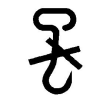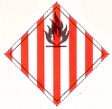| Kapok | [German version] |
Table of contents |
|
| General: | ||
| Product information | ||
| Packaging | ||
| Transport | ||
| Container transport | ||
| Cargo securing | ||
Product information
Product name
| German | Kapok |
| English | Kapok |
| French | Kapok |
| Spanish | Kapok |
| Scientific | Ceiba pentandra, Ceiba occidentalis |
| CN/HS number * | 1402 10 ff. |
(* EU Combined Nomenclature/Harmonized System)
Product description
Kapok belongs to the category fibers/fibrous materials, which are classified as follows [24]:
Plant hairs:
| Cotton seed-hairs | |
| Kapok tree fruit hairs |
Stalk fibers from dicotyledonous plants (soft fibers):
| Flax, ramie (fine spinnable fibers) | |
| Hemp, jute, kenaf (coarse spinnable fibers) |
Leaf fibers from monocotyledonous plants (hard fibers):
| Sisal, Manila hemp, palm fibers (poor spinning characteristics) |
Bast:
| Linden, raffia palm, willow |
Basketwork material:
| Coconut fiber, rattan cane, halfa, piassava, esparto |
Kapok is the fine, silkily lustrous fruit fibers from the fruit walls of the capsules, 10 – 20 cm in length and 3 cm in thickness, of the kapok tree (Ceiba pentandra). The kapok tree is a member of the bombax family (Bombacaceae). It is also known as the silk cotton tree or ceiba.
Originally native to South America, it is now to be found in all tropical countries. Growing to a height of 50 m, kapok trees are among the tallest of tropical rain forest trees.
The kapok hairs, 10 – 35 mm in length, which are plant hairs, are brittle and only spinnable when blended with cotton. The fibers are thermally insulating and water-repellent. Kapok fibers may be white, light gray, yellowish to brown and lustrous. They are also known as ceiba or Java cotton.
Quality / Duration of storage
The most commonly traded varieties are Java kapok and the lower grade Indian kapok.
Moisture may cause a musty odor, but this disappears on drying.
Low quality kapok may contain dirt and rotten fibers and may occasionally be mixed with old kapok from old upholstery.
Subject to compliance with the appropriate temperature and moisture conditions, duration of storage is not a limiting factor as regards transport and storage life.
Intended use
Due to their lignification, kapok fibers are not suitable for spinning, but are an excellent, robust upholstery stuffing. Kapok fibers are thus used as stuffing for upholstery, bedding and for acoustic and thermal insulation. Kapok hairs are not wettable and are thus used for filling life jackets and life belts because the large, air-filled lumen ensures that the kapok fibers have a low density and good buoyancy. Even after extended immersion in water, buoyancy declines only slightly.
Figure
(Click on the individual Figures to enlarge them.)
 Figure 1 |
 Figure 2 |
Countries of origin
This Table shows only a selection of the most important countries of origin and should not be thought of as exhaustive.
| Europe | |
| Africa | Nigeria, Mozambique, Tanzania |
| Asia | Sri Lanka, Indonesia, Thailand, Philippines |
| America | Ecuador |
| Australia |
Back to beginning
Packaging
Kapok is transported unpackaged in bales of approx. 90 – 100 kg. Since kapok cannot withstand strong compression, the bales are compressed under only moderate pressure and are thus relatively large. The bales are strapped with steel strapping to ensure that they hold together better.
| Marking of packages | ||
 Keep dry |
 Use no hooks |
 Keep away from heat (solar radiation) |
Back to beginning
Transport
Symbols
 Spontaneously combustible, Class 4.2 IMDG Code |
 Fire hazard (Flammable solids), Class 4.1 IMDG Code |
 General cargo |
Means of transport
Ship, truck, railroad
Container transport
Standard containers, subject to compliance with water content of goods, packaging and flooring.
Cargo handling
In damp weather (rain, snow), the cargo must be protected from moisture, since kapok is strongly hygroscopic and readily absorbs moisture. Although kapok is naturally water-resistant, wetting can result in discoloration, mustiness and decay. In addition, kapok may swell by absorbing water vapor, resulting in an increase in volume.
Do not use hooks for cargo handling, since they may lead to sparking when they come into contact with the strapping. In addition, smoking is absolutely prohibited during cargo handling.
Danger: the dust generated by cargo handling may ignite explosively.
Stowage factor
| 3.40 – 5.20 m3/t (bales, moderately compressed) [1] | |
| 1.67 – 1.81 m3/t (bales, compressed) [11] | |
| 3.34 – 4.74 m3/t (bales) [11] | |
| 3.54 – 5.10 m3/t (bales) [14] |
Stowage space requirements
Cool, dry
Segregation
Fiber rope, thin fiber nets
Cargo securing
The cargo is to be secured in such a way that the bales or strapping are not damaged. Undamaged strapping is essential to maintain compression of the bales during transport. If the strapping is broken, compression is diminished, which at the same time results in an increased supply of oxygen to the inside of the bales. This in turn increases the risk of combustion or feeds a fire which has already started. Bursting or chafing of steel strapping may lead to sparking and external ignition.
Back to beginning
Risk factors and loss prevention
RF Temperature
Kapok requires particular temperature, humidity/moisture and possibly ventilation conditions (SC VI) (storage climate conditions).
Favorable travel temperature range: no lower limit – 25°C
Kapok must be stowed away from heat sources.
Every hold should be equipped with means for measuring temperature. Measurements must be performed and recorded daily.
Back to beginning
RF Humidity/Moisture
Kapok requires particular temperature, humidity/moisture and possibly ventilation conditions (SC VI) (storage climate conditions).
| Designation | Humidity/water content | Source |
| Relative humidity | 70% | [1] |
| Water content | 8.5% | [14] |
| Maximum equilibrium moisture content | 65% | [1] |
Kapok behaves strongly hygroscopically (hygroscopicity) and this naturally water-resistant product must therefore be protected from seawater, rain and condensation water and from excessive relative humidity in order to avoid decay, discoloration and mustiness. In addition, kapok may swell by absorbing water vapor, resulting in an increase in volume.
For this reason, moisture levels should be measured when a consignment is accepted. Moisture-damaged bales must not be accepted.
Back to beginning
RF Ventilation
Kapok requires particular temperature, humidity/moisture and possibly ventilation conditions (SC VI) (storage climate conditions).
If the product is loaded for shipment in a dry state, it does not have any particular ventilation requirements. Problems arise if the product and/or ceiling/flooring are too damp. In this case, the following ventilation measures should be implemented:
Air exchange rate: 10 changes/hour (airing)
Since kapok very readily absorbs oxygen, before anybody enters the hold, it must be ventilated and, if necessary, a gas measurement carried out, since a shortage of oxygen may endanger life.
Back to beginning
RF Biotic activity
Kapok displays 3rd order biotic activity.
It belongs to the class of goods in which respiration processes are suspended, but in which biochemical, microbial and other decomposition processes still proceed.
Back to beginning
RF Gases
Kapok very readily absorbs oxygen. An oxygen shortage may therefore arise in closed holds and containers. Before anybody enters such holds, the holds must be ventilated and, if necessary, a gas measurement carried out.
The increase in CO2 and CO content indicates a cargo fire. The TLV of the hold air is 0.49 vol.%. As a result of the oxygen-rich lumen, bales often burn for weeks without being discovered.
Back to beginning
RF Self-heating / Spontaneous combustion
Kapok is assigned to Class 4.1 of the IMDG Code (Flammable solids). However, its specific characteristics and negative external influences (see below) may cause it to behave like a substance from Class 4.2 (Substances liable to spontaneous combustion) of the IMDG Code or ADR.
Its high cellulose content makes kapok particularly liable to catch fire through external ignition. Kapok fibers ignite even more readily than cotton. Therefore, protection from sparks, fire, naked lights and lit cigarettes must always be provided. Smoking is absolutely prohibited. Sparks may arise from bursting or chafing of the steel straps (and also as a result of inadequate cargo securing in the hold or container) and cause a cargo fire. In accordance with the IMDG Code, ventilation openings leading into the hold should be provided with spark-proof wire cloth.
Spontaneous combustion may occur as a result of exposure to moisture, animal and vegetable fats/oils, oil-bearing seeds/fruits, copra and raw wool. As a result of the very well developed oxygen-rich lumen of the kapok fiber and the oxygen supply contained in the capillary cavity system, smoldering fires inside the bales often last for weeks.
Kapok generally combusts very slowly and flamelessly. Once fire is well established in kapok bales, they burst open due to the intensity of the heat and burning kapok may then be scattered over other bales.
Fire-fighting is best performed using CO2 or foam. It is very difficult to extinguish a fire because of the excess of oxygen in the kapok fiber, which maintains the fire from the inside. When fighting a fire, do not break the steel straps or open the bales, since relieving the compression increases the oxygen supply and makes it impossible to fight the fire effectively.
Water must not be used for fire-fighting, since the swelling capacity of the kapok fibers may cause damage to the hold or container walls.
Back to beginning
RF Odor
| Active behavior | Kapok is normally odorless. Moisture may cause a musty odor, but this disappears again on drying. |
| Passive behavior | Kapok is sensitive to unpleasant or pungent odors. |
Back to beginning
RF Contamination
| Active behavior | Kapok causes contamination by forming dust. |
| Passive behavior | Kapok is sensitive to contamination by dust, dirt, fats/oils and rust as well as oil-containing goods, such as oil-bearing seeds/fruits, copra, raw wool etc., since oil-impregnated fibers promote self-heating/cargo fire. Holds or containers must accordingly be clean and in a thoroughly hygienic condition. Low quality kapok may contain dirt and rotten fibers and may occasionally be mixed with old kapok from old upholstery. |
Back to beginning
RF Mechanical influences
Care must be taken to ensure that mechanical influences do not cause damage to strapping, which increases the risk of fire by relieving the compression of the bales and allowing a greater supply of oxygen.
Back to beginning
RF Toxicity / Hazards to health
Since kapok is highly oxygen-absorbent, a life-threatening shortage of oxygen may arise in the hold or container. Thus, before anybody enters the hold, it must be ventilated and, if necessary, a gas measurement carried out. The TLV for CO2 concentration is 0.49 vol.%.
Back to beginning
RF Shrinkage/Shortage
Losses in volume are possible due to improper cargo handling.
Back to beginning
RF Insect infestation / Diseases
Due to its content of bitter substance, kapok is not attacked by pests.
Back to beginning
